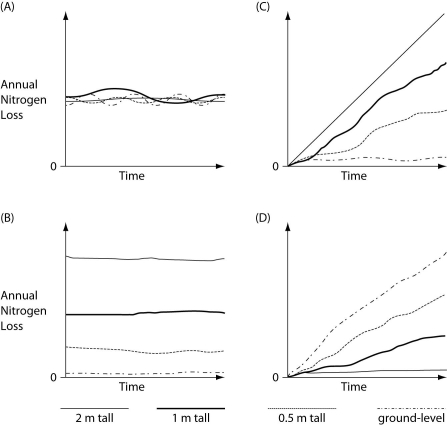Multiple Choice
Refer to the following information to answer the next few questions.
Researchers decided to test the hypothesis that if the 2-m tall Polytrichum gametophyte-sporophyte plants had acted as a physical buffer, then they would have reduced water's ability to erode the soil and carry away its nitrogen. They began with four equal-sized areas where Polytrichum mosses grew to a height of 2 m above the soil surface. One of the four areas was not modified. In the second area, the mosses were trimmed to a height of 1 m above the soil surface. In the third area, the mosses were trimmed to a height of 0.5 m above the soil surface. In the fourth area, the mosses were trimmed all the way to the ground, leaving only the rhizoids. Water, simulating rainfall, was then added in a controlled fashion to all plots over the course of one year. Figure 29.2 presents four graphs that depict potential results of this experiment.

Figure 29.2
-If the actual results most closely resembled those in Figure 29.2(A) , then a further question arising from these data is: "Do the Polytrichum rhizoids have to be alive in order to reduce soil nitrogen loss, or do dead rhizoids have the same effect?" Arrange the following steps in the correct sequence to test this hypothesis.
1) Add metabolic poison to the soil of the experimental plot of mosses.
2) Apply water equally to the experimental and control plots.
3) Measure initial soil nitrogen contents of control and experimental plots.
4) Determine nitrogen loss from soil of control and experimental plots.
5) Establish two identical plots of Polytrichum mosses; one as a control, the other as the experimental treatment.
A) 5 → 1 → 3 → 2 → 4
B) 5 → 2 → 3 → 1 → 4
C) 5 → 3 → 1 → 2 → 4
D) 4 → 5 → 1 → 3 → 2
E) 5 → 3 → 2 → 1 → 4
Correct Answer:

Verified
Correct Answer:
Verified
Q26: <img src="https://d2lvgg3v3hfg70.cloudfront.net/TB5463/.jpg" alt=" Figure 29.3
Q27: The next question is based on the
Q28: Which of the following was not a
Q29: Arrange the following terms from most inclusive
Q30: As is true of the gametophytes of
Q32: During glacial periods in the early evolution
Q33: Beginning with the germination of a moss
Q34: Big Bend National Park in Texas is
Q35: Which of the following are land plants
Q36: Evidence indicates that plants increase the number